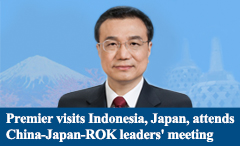China and Japan must work together to build sustainable ties
2018-05-07
China Daily
Premier Li Keqiang will pay an official visit to Japan this week, the first by a Chinese premier in nearly seven years. He will also hold trilateral talks with Japanese Prime Minister Shinzo Abe and Republic of Korea President Moon Jae-in on May 9.
The annual summits of the leaders of China, Japan and the ROK, last held in 2015, will resume on May 9.
State Councilor Wang Yi, who is also foreign minister, visited Tokyo last month to prepare for Premier Li’s visit. Apart from meeting with Abe, Wang also co-chaired a high-level economic dialogue-which had been suspended since 2010-with his Japanese counterpart Taro Kono.
Wang’s visit to Japan was an important step to put bilateral relations on the right track. Political exchanges between the two countries were frozen for more than a decade because of former Japanese prime minister Junichiro Koizumi’s frequent visits in the early 2000s to Yasukini Shrine that honors, among others, 14 Class-A Japanese war criminals. And former Yoshihiko Noda government’s move to “nationalize” China’s Diaoyu Islands in September 2012 dealt another severe blow to Sino-Japanese ties, so did Abe’s Yasukuni Shrine visit in 2013.
Since it took more than one wrong move by Japanese politicians to freeze bilateral ties, it will take time to break the ice.
The good news is that a thaw in bilateral relations might have started.
At a news conference in March, Premier Li said improvement of China-Japan relations requires not just the right atmosphere, but also the vision and commitment from both sides.
In October 2016, in his second month of his second term in office, Abe tried to mend bilateral ties by visiting Beijing. The so-called ice-breaking trip was preceded by Premier Wen Jiabao’s Japan visit to Japan almost a decade ago, in the spring of 2007, and Japanese Prime Minister Yasuo Fukuda’s trip to China in the winter of the same year.
In May 2008, then President Hu Jintao visited Japan, the first by a Chinese leader in a decade, when he and Fukuda signed a joint statement on all-around promotion of strategic relations for mutual benefit.
Along with the China-Japan Joint Statement issued in September 1972, the China-Japan Treaty of Peace and Friendship inked in August 1978 and the China-Japan Joint Declaration released in November 1998, the 2008 joint statement became the fourth political document serving as the political basis for stable growth of China-Japan relations.
Anniversaries of these documents have served as a catalyst for bringing the two countries closer. On Sept 29 last year, Abe and his newly appointed Foreign Minister Taro Kono and former Prime Minister Fukuda, attended the Chinese Embassy’s gala program to observe the 45th anniversary of the normalization of diplomatic relations between the two countries.
The 40th anniversary of the signing of the Sino-Japanese Treaty of Peace and Friendship this year, the G20 Summit in Osaka in 2019, the Olympic Games in Tokyo in 2020 and the Winter Olympics in Beijing in 2022 all will be good opportunities for the two countries to improve bilateral ties.
China has rolled out new policies and measures to deepen reform and opening-up, which are also expected to promote economic exchanges between Beijing and Tokyo and thus improve bilateral ties. But whether Sino-Japanese ties will be back on the right track depends on Japan’s actions. If the two countries can really become “each other’s cooperation partners rather than threats (to each other)”, their relationship will stay stable and not be subject to change, especially because of the United States’ China policy.
Beijing and Tokyo agree that high-level exchanges can play a leading role in improving bilateral ties. But Premier Li has warned that a wrong move by Japan could herald the return of the “chilly” relationship.
So Premier Li wants the two sides to work together for the sustained development of bilateral ties.


